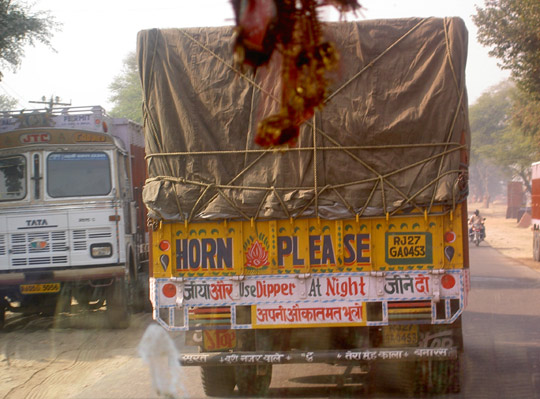
We have just gotten back from a three-day trip to Agra (more on that, separately). We had a hired car and driver, which turned out to be a 9-seat van and driver-plus-assistant. It’s a good way to travel because you see a lot of Indian life right on the roadsides, and the driver knows his way to all of the monuments and shopping and takes you wherever you want to go whenever you want to go, and waits for you until you get back.
With a stop at the Rajastan Motel for breakfast, it was a 5-hour trip from our apartment to the Clark’s Shiraz Hotel, where we checked into rooms on the fifth floor (top floor) with a view of both the Taj and the Red Fort (at least until the fog rolled in). It’s a four lane divided highway new since we were here in 1998. There is a 10 to 15 foot median strip filled with bougainvillea that was all in bright-red bloom. They neglected to make provision for the movements of the villagers who live literally right on the edge of the road and whose farm fields may be on the other side, so there are inventive coping strategies, like removal of the stone curbs so carts can go across the median strip.
Virtually every truck has painted on it “Horn Please”, as you can see from the photo. These are painted by people who are not necessarily readers of, or even speakers of, English. The letters become more of a design element in what can be beautifully elaborate folk art extravaganzas. It does not seem like drivers need this invitation; people use their horns all the time. At night, the honking is replaced by flicking the headlights, hence the “Use dipper at night” phrase.
Rob asked, “What does it mean when they honk their horns?” So we started keeping track of all the different things it can mean. Here is a compilation of the 10 most frequent, told from the point of view of the driver, but translated into American English but without the expletives. The amazing thing is that the honking seems to replace road rage. You hardly ever see angry drivers.
10. “Dude! I don’t care if you are trying to board that bus while its in motion, get your body out of my lane!”
9. “I’m passing you in the passing lane.”
8. “You may be in the passing lane, but I am passing you in the driving lane and want you to know I’m here.” [#10, 9 and 8 require a long, continuous honk].
7. “I’m passing you in the passing lane, and you need to get over into the breakdown lane. There is an oncoming car headed the wrong direction in my lane so I NEED TO move over into your lane QUICK.”
6. Variant of number 8: “I’m in the driving lane, passing you who are in the passing lane, but I need to get ahead of you QUICK because there is a water buffalo hauling a cart of bricks in my lane.” [#7 and 6 require very urgent short bursts of honking.]
5. “I’m starting a new third lane up the middle and I want you to veer over a few inches to let me through.”
4. Another variant of number 8: “I am in the driving lane, and I want you in the car ahead of me to pull over into the passing lane so that I can pass you and the car I am already overtaking in the passing lane” [Continuous honking required].
3. “I am coming through, and my horn will make you disappear.” [Applies to any object smaller than the vehicle you are in: pedestrian, bicycle, scooter, dog, carts. Requires short bursts of honking in inventive rhythms].
2. “I want to pass you, so you need to get out of my lane (I don’t care where to) and let me by.” [Requires continuous honking, and is usually done when my vehicle is so close to the back-end of yours that you can’t see me].
1. “I have nothing else to do right now. I think I’ll honk my horn.”


